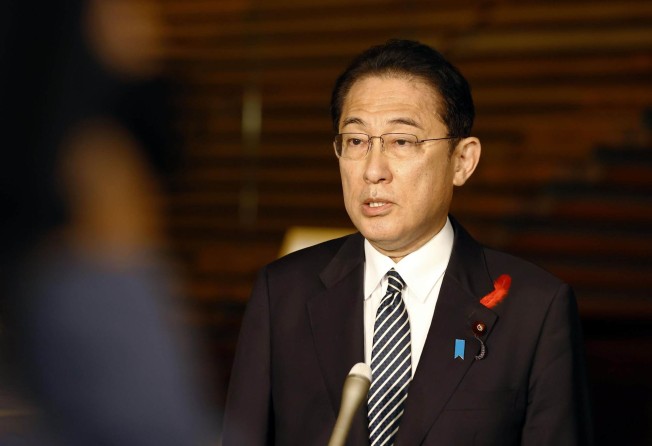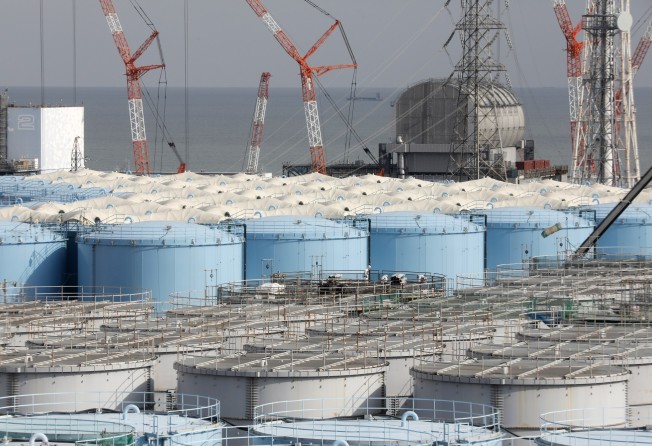
Japan’s return to nuclear power faces test as new leader Kishida visits Fukushima
- The new prime minister has committed to restarting reactors mothballed since the 2011 meltdown, but public opposition and his own upbringing in Hiroshima may test his resolve
- Amid a global power crunch, the business lobby and several of Kishida’s ministers argue that nuclear is the only way to secure Japan’s power supplies and meet its carbon targets. A fully green alternative could be 30 years away

As he observes the twisted remains of three nuclear reactors and row upon row of steel tanks holding an estimated 1.25 million tons of highly radioactive water at the Fukushima nuclear plant on Sunday October 17, Japan’s new leader will be conflicted.
Prime Minister Fumio Kishida has said he remains committed to atomic energy and intends to restart plants that have been mothballed since the magnitude-9 earthquake and tsunami triggered the disaster at Fukushima in March 2011 – but there are many who feel he will have a heavy heart over that decision when he pays his first visit to the crippled plant.
On Monday, in his first question-and-answer session in the Diet since being elected head of the ruling Liberal Democratic Party in late September and subsequently being confirmed as prime minister, Kishida indicated that he would be sticking to the policies of his two immediate predecessors as prime minister, Yoshihide Suga and Shinzo Abe.
“It is crucial that we restart nuclear plants,” Kishida said in response to a question from an opposition politician, adding that those plants that met stringent new safety standards imposed in the aftermath of Fukushima were a key component of the government’s commitment to reaching carbon neutrality by 2050.

Prior to 2011, 54 nuclear reactors were generating 30 per cent of the nation’s energy and there was a plan to raise that to 40 per cent as part of the national strategic priority. Twenty-four older reactors that failed to meet new safety standards are being permanently decommissioned, but many more have been certified to resume operations. A mere nine reactors at five plants have started generating electricity, however, due to the opposition of people living close to the facilities and local governments.
Nevertheless, successive governments have come under pressure from the powerful energy lobby and domestic businesses to restart reactors. Kishida’s administration is under renewed pressure from within the party, with several of the ministers that he appointed to his cabinet vociferously in favour of nuclear energy.
One of the strongest proponents of restarting the plants is Akira Amari, a former minister of economy, trade and industry and a close ally of Abe until he was forced to resign in 2016 after being accused of accepting bribes from a construction company. Amari has kept a low profile in the intervening years, but has in the past stated that nuclear energy is “a must” if Japan is to pivot away from its reliance on fossil fuels.
“Kishida is going to follow in the footsteps of Suga and Abe on this issue, as he is doing on most of his policies, but I am not sure he is completely convinced” this is the best course of action, said Go Ito, a professor of political science at Tokyo’s Meiji University.
“Kishida is from Hiroshima, a constituency that is completely opposed to anything to do with nuclear energy and that will have influenced him,” he said.

“For now, I would say he recognises that nuclear energy is the only pragmatic way forward, that this is reality, especially if we want to meet our carbon emission commitments, but I expect he will be looking for ways to gradually reduce our reliance on nuclear power in favour of renewable energy sources,” he said. “And I would say that the majority of the public would support that ambition.”
Kaoru Yamaguchi, a senior research fellow at the Institute of Energy Economics, Japan, disagreed with that assessment and was convinced that Kishida was “eager to promote nuclear power, primarily because he realises it is the most effective way of meeting the carbon neutral target.”
Under its present commitment, Japan is aiming to be carbon neutral by 2050, although experts suggest that might be difficult to achieve. Between 1990 and 2019, Japan’s carbon output fell by just 5 per cent to 1.1 billion tons – a poor return in comparison with the 38 per cent reduction achieved by the United Kingdom and the 33 per cent recorded by Germany in the same period.
“Kishida is under pressure from industry, power companies, the ministry and advisers like Amari on nuclear energy and they are telling him that it is a carbon-neutral form of energy and that it will secure the nation’s energy security,” Yamaguchi said.
He added that while the prime minister would undoubtedly be attracted by the idea of renewable power – Japan has been shown to have excellent potential for solar, offshore wind, tidal, geothermal and other forms of “green energy” – he will also have been informed that the technology required to provide an uninterrupted supply adequate to meet the nation’s needs is still at least 30 years off.

Yamaguchi said it might be impossible to convince the Japanese public of the safety of the older reactors that dot the nation – the first plant, at Tokai in Ibaraki prefecture, was commissioned in 1966 – but newer generations of reactors were far more sophisticated and resilient to earthquakes and other security challenges.
“The accident at Fukushima was the result of a problem with the design, but if new reactors could be built then they would certainly be better than earlier versions in terms of safety,” he said.
That may well be an option for Kishida – one of his rivals in the party leadership election repeatedly outlined plans for miniaturised nuclear plants to replace decommissioned units – yet the largest hurdle will be communicating to the public that they will not experience a repeat of March 2011.
Yet the world’s worsening energy concerns have encouraged other countries to reconsider their earlier resistance to atomic energy. France, for example, has announced that it will invest 1 billion euros (US$1.16 billion) in small-scale nuclear power plants by the end of the decade and return atomic energy to the single most important element of the national energy mix.
China is also investing heavily in nuclear power as it attempts to shift its own carbon footprint, while there is still debate in Southeast Asian nations about the benefits and downsides of constructing atomic plants. Malaysia, Indonesia, Vietnam and Thailand are considered to be among the front-runners for the first nuclear plant in the region, which some analysts suggest could be operational as soon as 2030, although barriers still remain.
Those barriers may be regulatory, financial, security-based or simply due to a lack of the necessary human resources, but all those nations are also subject to occasional natural disasters and the events of March 2011 in Japan will weigh heavily upon any final decision.
Hideyuki Ban, co-director of the Citizens’ Nuclear Information Centre, said Kishida’s refusal to embrace renewable energy and turn Japan into the world leader in different renewable technologies was a “missed opportunity”.
“I had hoped that Taro Kono would win the LDP leadership election as he has said in the past that he would be in favour of phasing out nuclear energy and the widespread adoption of alternative sources of power,” he said.
“My concern now is that the government will start to pressure local governments and people living close to reactors that have yet to resume operations because they want them to start again,” he said. “And then, I expect the government will start to tell us that new plants are needed to replace the ones that have been shut down and that these reactors use new technology and are ‘completely safe’.”
“The nuclear lobby is very strong and the business sector has a lot of influence over politics, so that is only to be expected,” he said. “But I still believe that Japan can meet its carbon commitments – and even meet the government’s zero-carbon promise sooner than 2050 – by developing the technologies required to adopt large-scale renewable energies.”
Ban said more than 100 local authorities across Japan had declared themselves to be 100 per cent powered by renewable energy, adding, “If it can be done on a local level, then it can be done on a regional level and then on a national scale.
“All it needs is the political will.”
